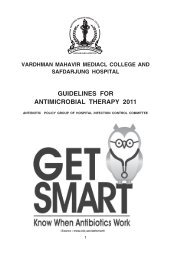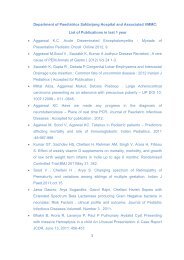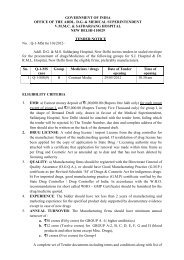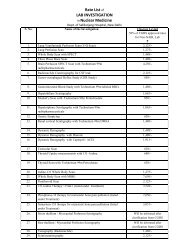Guidelines for INFECTION CONTROL POLICY - Safdarjung Hospital
Guidelines for INFECTION CONTROL POLICY - Safdarjung Hospital
Guidelines for INFECTION CONTROL POLICY - Safdarjung Hospital
You also want an ePaper? Increase the reach of your titles
YUMPU automatically turns print PDFs into web optimized ePapers that Google loves.
Anatomic wasteBiomedical andhealth-care wasteChemical wasteCollectionContainerDecontaminationDisinfectantDisposalExposureCytotoxic wasteHIV/AIDSIncinerationInfectious health-IrradiationConsisting of recognizable body partssolid or liquid waste arising <strong>for</strong>m health-care (medical) activitiessuch as diagnosis, monitoring, treatment, prevention of disease oralleviation of handicap in human or animals, including related research,per<strong>for</strong>med under the supervision of a medical practitioner or veterinarysurgeon or another person authorized by virtue of this professionalqualificationsConsisting of/or containing chemical substances.the act of removing accumulated containerized solid waste from thegenerating source. Private collection of solid and liquid waste byindividuals or companies from residential, commercial, health facilityor industrial premises. The arrangements <strong>for</strong> the service are madedirectly between the owner or occupier of the premises and thecollectorvessel in which waste is placed <strong>for</strong> handling, transportation. storageand/or eventual disposal. The waste container is a component of thewaste package.the process of reducing or eliminating the presence of harmfulsubstances such as infectious agents so as to reduce the likelihoodof disease transmission from those substanceschemical agent that is able to reduce the viability of micro-organismsIntentional burial, deposit, discharge, dumping, placing or release ofnay waste material into or on any air, land or water.the amount of radiation or pollutant present in a particular environment(i.e. human, natural) which represent a potential health threat to theliving organisms in that environmentcytotoxic/Genotoxic waste is highly hazardous and may havemutagenic, terato-genic, or carcinogenic properties. It raises serioussafety problems, both inside hospitals and after disposal, andshould be given special attention. Genotoxic waste may includecertain cytostatic (antineoplastic) drugs. These powerful drugs havespecific destructive action on action cells (often used in chemotherapyof cancer).HIV (Human Immuno-deficiency Virus) is the virus that causesAIDS (Acquired Immune Deficiency Syndrome). Over time, infectionwith HIV can weaken the immune system to the point that thesystem has difficulty fighting off certain infections that in turn canlead to death.discarded materials from health-care activities on humans or animalswhich have the potential of transmitting infectious agents to humans.These include discarded materials or equipment <strong>for</strong>m the diagnosis,treatment and prevention of disease, assessment of health statusor identification purposes, that have been in contact with blood andits derivatives, tissues, tissue fluids, or wastes from infectionisolation wards.exposure to radiation of wavelengths shorter than those of visiblelight (gamma, x-ray or ultraviolet) <strong>for</strong> medical purpose, the destructionof bacteria in milk or other foodstuffs or initiation of polymerizationof monomers or vulcanization of rubber.the application of activities such as waste reduction, reuse andrecycling care waste to minimize the amount of waste that requiresdisposal.32
















